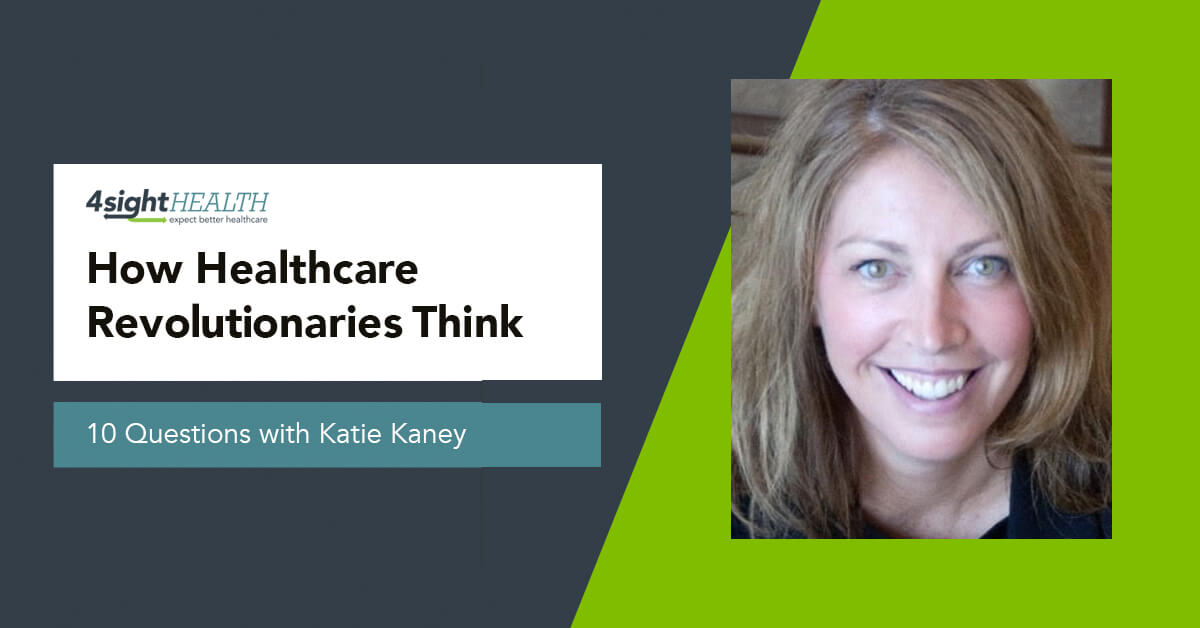February 11, 2025

How Healthcare Revolutionaries Think: 10 Questions With Katie Kaney
Welcome to the latest installment of 4sight Health’s series, How Healthcare Revolutionaries Think. Our interview series profiles healthcare instigators who believe that outcomes matter, customers count and value rules.
Those three parts add up to the 4sight Health ethos. How many parts add up to your health? According to Katie Kaney, there are four: clinical, social, genetics and behavior. Kaney is the founder of the Whole Person Index (WPI), a standardized, evidence-based predictive assessment tool that uses those four drivers to prioritize actions for individuals, populations, and communities. Kaney implements the tool in partnership with VOX Telehealth, based in Pennington, New Jersey, which quantifies those four domains and provides education, resources, behavior science expertise and concierge navigation to achieve better health. Their target users are employers, payers and health systems nationally.
I spoke with Kaney about why today’s healthcare system skews that balance, who’s in the best position to get them in balance and what we need to do to produce better outcomes at lower cost for everyone.
You also can listen to my podcast interview with Kaney on what she’s doing as the CEO of LovEvolve to improve maternal health in the U.S.
1. Katie let’s start with the first question we asked everyone in this series, and that’s your definition of a healthcare revolutionary. What’s yours?
Kaney: A healthcare revolutionary is really someone who is accountable for better outcomes at a lower cost for everybody, and who’s not afraid to be measured by those metrics. Those of us who have been in healthcare — I’m 52, and I started in healthcare when I was about 18 — know our metrics haven’t gotten any better. We have not met those — better health, lower cost for all. A healthcare revolutionary is not afraid and willing to look those metrics in the face and do something about it.
2. Not being afraid is part of your definition. Do you think a lot of people in healthcare are afraid to be measured? Or that there’s a natural resistance to being measured?
Kaney: It’s not that. It’s that we’re not all playing by the same rules or even the same game. There’s not a common scorecard. We’re measuring all kinds of things. The healthcare system has measures. Public health has measures. We individually have measures for what we want to be in terms of our own health. We’re measuring and measuring. But I don’t think there’s an ultimate measure that says we’re winning. If we’re going to make any type of progress, we have to agree on those bigger measures and be able to be held accountable for those measures.
3. Do you have a favorite healthcare revolutionary past or present who fits your definition and is not afraid to be held accountable for improving outcomes and lowering costs for everyone?
Kaney: I don’t. Individual people can have courage. They can speak up. They can start to drive change. But ultimately, it’s going to take convening for us to do it. There’s not one single point or person. That’s what I’m trying to do — be part of the convening of people who want to make a difference and want to be held accountable for what people are counting on us for, which is better health at lower cost. But I do think there are a couple of systems that are close to being revolutionary.
4. Systems as in health systems or systems as in industry sectors, processes or disciplines?
Kaney: Systems as in discipline. Systems that are furthest along the revolutionary spectrum. They’re not perfect. No systems are perfect. But they offer lessons for others to follow. Examples of how to be more patient-centric and get the outcomes we all want.
5. OK, what are the two revolutionary systems that we should be emulating to improve health and lower costs for everyone?
Kaney: The first is hospice. I’ve been a volunteer within the hospice system for 28 years. I’ve been a respite volunteer. I spend time on the frontline with patients. That system is pretty incredible. So, it’s patient-centered — you can get care in your home if you need to. It’s holistic — there’s support for the family. Most people who are enrolled or have participated in hospice have a very good experience in a very tough situation. If you look at the data and the outcomes, it’s better care at lower cost. From an equity point of view, there are really no barriers, right? It’s available to everyone.
The second is EMS (emergency medical services). I spent a lot of my time in acute-care facilities. I was fortunate enough to run helicopters, airplanes and ambulances for most of my life, coordinating with local and county EMS. If you look at that staffing model from an efficiency point of view, you have one physician and you have the paramedics team — the EMS personnel, the EMTs, the people in the dispatch center. That system is pretty efficient. You’re able to distribute what emergency services people need across the community, and you’re also able to deliver care within peoples’ homes, right? We’re always talking about meeting patients where they’re at.
Those are two revolutionary systems — hospice and EMS — that we can look at to learn how to be more efficient without compromising quality.
 6. Do you consider yourself a healthcare revolutionary?
6. Do you consider yourself a healthcare revolutionary?
Kaney: I do. But if I measure my success so far, I’m not anywhere where I’d like to be. When I look back, we were one of the first health systems to put mid-level providers like nurse practitioners in the trauma center and in the emergency department. I championed telemedicine back in the early 2000s. We set up one of the first hospital-at-home programs in 2014. We put care management on a virtual platform. We integrated behavioral health. None were my ideas. I was smart enough to listen to clinicians on the front lines telling us administrators about how we can make things better and easier for our patients. I loved working with the front-line teams. Anybody on the front lines taking care of patients is your best asset. I championed the underdogs. I don’t want people like that to be underdogs who need a champion. All of us must work together to build the healthcare system that we all need.
7. All of that was as a chief administrative officer or in other administrative leadership positions at a health system. How did those experiences shape how you think about healthcare today?
Kaney: I guess it shaped how I think about healthcare in three ways. First, it’s clear that we don’t have a common set of metrics to measure our performance, and we need one. I said that earlier. Without one, we can’t move the needle. Second, we don’t have a clear understanding of how we can best help people get healthy and stay healthy. How do we help individuals improve their health status? Third is we don’t have a clear understanding of how we can improve the health of populations. We might have solutions that work for individuals, but you also need solutions that work for populations. And all three should be integrated and work together. Metrics, individual health and population health.
8. Where did your definitions of whole person health and your Whole Person Index come from? The idea that health is divided into four domains: behavior (40%), genetics (30%), social (20%) and clinical (10%)? We clearly spend most of our healthcare dollars on clinical at the expense of the other three. When did those light bulbs go on?
 Kaney: It was a culmination. Being a real person in the real world, trying to live a healthy lifestyle. Trying to help people because you’re accountable to that community and that population. When you look at all of the fun things we got to do or new systems that we got to build, they weren’t working for everyone. It wasn’t enough. They weren’t working for the population as a whole. When I started doing research for the book, I kept coming across the definition of health. The definition of health is clinical, social, genetic and behavior. This isn’t new. Then I tried to find somebody who was measuring health across all of those four domains and who was trying to fit those pieces together in the right way. I couldn’t find anyone. So, that’s why I founded the Whole Person Index.
Kaney: It was a culmination. Being a real person in the real world, trying to live a healthy lifestyle. Trying to help people because you’re accountable to that community and that population. When you look at all of the fun things we got to do or new systems that we got to build, they weren’t working for everyone. It wasn’t enough. They weren’t working for the population as a whole. When I started doing research for the book, I kept coming across the definition of health. The definition of health is clinical, social, genetic and behavior. This isn’t new. Then I tried to find somebody who was measuring health across all of those four domains and who was trying to fit those pieces together in the right way. I couldn’t find anyone. So, that’s why I founded the Whole Person Index.
9. You say we spend 80% of our healthcare dollars on clinical with the other three domains fighting over the scraps. Who’s in the best position to redistribute all the money the right way to improve outcomes and reduce costs for everyone? Providers? Insurers? Employers? Patients? Government?
Kaney: You have to talk about incentives. Who has the biggest incentive to do that? If you look at who pays for healthcare, it’s employers. They cover and pay for care more than anyone else. If you have that buying power, you can make those changes. But the only thing employers have to work with is claims data from their broker or insurer. The claims data can create a clinical profile of their employees, and more than likely it’s a retrospective sickness profile, not a health profile.
Employers need to round out that claims data with self-reported data from the employees across all four drivers of health. Employers can learn what they need for their employees. It could be help with mental health. It could be help with nutrition. It could be help with affordability. Employers can learn what their populations need for their health, not just for their healthcare. They could use their buying power to build a marketplace that matches what they need for their populations — a marketplace that offers services to cover the four domains in the right proportion.
It’s hard. We’re all OK with a mediocre system. No one wants to crack the door open just a little to help us do better. We hold on so tight to mediocrity.
10. That’s a tough message for healthcare to hear. Time to let go of mediocrity. You do a lot of public speaking. How’s that message received?
Kaney: I wouldn’t say I necessarily enjoy public speaking, but I’m not afraid to speak the truth or answer things candidly from my perspective. You can’t make change if you don’t have conversations to level the playing field. I use public speaking to create a conversation so that we can talk to each other about ways we can change together. I’ve had great experiences with that, and I’ve had horrible ones, too.
When I’m talking about 10% clinical, 20% social, 30% genetic and 40% behavior, it’s not a fixed equation. Each one of us has a different percentage to define our health. Clinicians, sometimes they just heckle me like crazy. Clinical is hugely important. But you could be the best surgeon. You can operate on a patient. You can do the most perfect job. That’s great. But if the patient is not in balance with the other drivers, then the outcome is not going to be as good.
Burda’s Final Brief
Of all the pearls of wisdom Kaney dropped on me during our conversation, one stands out: “We hold on so tight to mediocrity.” That immediately resonated with me as a sports fan. Pick a sport, and you’ll find more than a few professional teams that always fill their stadiums or arenas with fans regardless of how lousy they are. Their owners rake in millions with no incentive to invest in their teams to improve them. That perfectly describes today’s healthcare system albeit the stakes in healthcare are much higher than the final score. We as patients (fans) continue to go to the doctor or hospital (stadiums and arenas) because we don’t invest in our health. Doctors and hospitals (the owners) have no incentive to invest in their services (teams) because they have a steady stream of patients (fans) regardless of how lousy their services are. That won’t change until we get the four domains of our health in the right balance. It’s time to let go of mediocrity and demand better outcomes for less cost for all.
 Katie Kaney is a proven corporate executive and strategic advisor who is trusted to advise and lead multidisciplinary teams in complex, highly regulated environments for growth, quality, and profitability. She served as Chief Administrative Officer at Atrium Health, a nationally recognized leader in shaping health outcomes through innovative research, education, and compassionate patient care with $11.3B total operating revenue, 70K teammates, 38 hospitals and care locations in N.C., S.C., and Georgia.
Katie Kaney is a proven corporate executive and strategic advisor who is trusted to advise and lead multidisciplinary teams in complex, highly regulated environments for growth, quality, and profitability. She served as Chief Administrative Officer at Atrium Health, a nationally recognized leader in shaping health outcomes through innovative research, education, and compassionate patient care with $11.3B total operating revenue, 70K teammates, 38 hospitals and care locations in N.C., S.C., and Georgia.
The Whole Person Index is here to keep it simple for health solutions and level the playing field. The goal is to accelerate monumental positive change for individual, population and community health outcomes.
Read more interviews with healthcare revolutionaries
Healthcare Revolutionary Hal Andrews
Healthcare Revolutionary Julie Murchinson
Healthcare Revolutionary David Terry
Healthcare Revolutionary Matt Marek
Healthcare Revolutionary Mark Engelen
Healthcare Revolutionary Chris Johnson
Healthcare Revolutionary Ramona Wallace, D.O.
Healthcare Revolutionary Alejandro Quiroga, M.D.
Healthcare Revolutionary Samir Goel
Healthcare Revolutionary Marcus Whitney
Healthcare Revolutionary Demi Radeva
Healthcare Revolutionary Michael Pitt, M.D.
Healthcare Revolutionary Rebeckah Orton
Healthcare Revolutionary Dan Trigub
Healthcare Revolutionary Bruce Brandes
Healthcare Revolutionary Lena Chaihorsky
Healthcare Revolutionary David Nash, M.D.
Healthcare Revolutionary Esther Dyson
Healthcare Revolutionary Meghan Conroy
See if your favorites are included in the series and let 4sight Health’s David Burda know who you consider to be a Healthcare Revolutionary.





